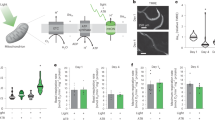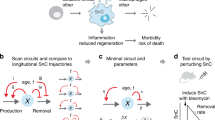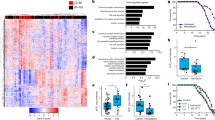Abstract
It has been theorized for decades that mitochondria act as the biological clock of ageing1, but the evidence is incomplete. Here we show a strong coupling between mitochondrial function and ageing by in vivo visualization of the mitochondrial flash (mitoflash), a frequency-coded optical readout reflecting free-radical production and energy metabolism at the single-mitochondrion level2,3. Mitoflash activity in Caenorhabditis elegans pharyngeal muscles peaked on adult day 3 during active reproduction and on day 9 when animals started to die off. A plethora of genetic mutations and environmental factors inversely modified the lifespan and the day-3 mitoflash frequency. Even within an isogenic population, the day-3 mitoflash frequency was negatively correlated with the lifespan of individual animals. Furthermore, enhanced activity of the glyoxylate cycle contributed to the decreased day-3 mitoflash frequency and the longevity of daf-2 mutant animals. These results demonstrate that the day-3 mitoflash frequency is a powerful predictor of C. elegans lifespan across genetic, environmental and stochastic factors. They also support the notion that the rate of ageing, although adjustable in later life, has been set to a considerable degree before reproduction ceases.
This is a preview of subscription content, access via your institution
Access options
Subscribe to this journal
Receive 51 print issues and online access
$199.00 per year
only $3.90 per issue
Buy this article
- Purchase on Springer Link
- Instant access to full article PDF
Prices may be subject to local taxes which are calculated during checkout




Similar content being viewed by others
References
Harman, D. The biologic clock: the mitochondria? J. Am. Geriatr. Soc. 20, 145–147 (1972)
Wang, W. et al. Superoxide flashes in single mitochondria. Cell 134, 279–290 (2008)
Fang, H. et al. Imaging superoxide flash and metabolism-coupled mitochondrial permeability transition in living animals. Cell Res. 21, 1295–1304 (2011)
Gavrilov, L. A. & Gavrilova, N. S. The quest for a general theory of aging and longevity. Science Aging Knowledge Environ. 2003 (28). RE5 (2003)
Szewczyk, A. & Wojtczak, L. Mitochondria as a pharmacological target. Pharmacol. Rev. 54, 101–127 (2002)
Alexeyev, M. F. Is there more to aging than mitochondrial DNA and reactive oxygen species? FEBS J. 276, 5768–5787 (2009)
Lemire, B. D., Behrendt, M., DeCorby, A. & Gaskova, D. C. elegans longevity pathways converge to decrease mitochondrial membrane potential. Mech. Ageing Dev. 130, 461–465 (2009)
Kenyon, C. J. The genetics of ageing. Nature 464, 504–512 (2010)
Bulina, M. E. et al. A genetically encoded photosensitizer. Nature Biotechnol. 24, 95–99 (2006)
Kenyon, C. et al. A C. elegans mutant that lives twice as long as wild type. Nature 366, 461–464 (1993)
Yang, W. & Hekimi, S. A mitochondrial superoxide signal triggers increased longevity in Caenorhabditis elegans. PLoS Biol. 8, e1000556 (2010)
Alavez, S. et al. Amyloid-binding compounds maintain protein homeostasis during ageing and extend lifespan. Nature 472, 226–229 (2011)
Maier, W., Adilov, B., Regenass, M. & Alcedo, J. A neuromedin U receptor acts with the sensory system to modulate food type-dependent effects on C. elegans lifespan. PLoS Biol. 8, e1000376 (2010)
Cho, S. C. et al. DDS, 4,4′-diaminodiphenylsulfone, extends organismic lifespan. Proc. Natl Acad. Sci. USA 107, 19326–19331 (2010)
Liao, V. H. et al. Curcumin-mediated lifespan extension in Caenorhabditis elegans. Mech. Ageing Dev. 132, 480–487 (2011)
Robida-Stubbs, S. et al. TOR signaling and rapamycin influence longevity by regulating SKN-1/Nrf and DAF-16/FoxO. Cell Metab. 15, 713–724 (2012)
Choi, S. S. High glucose diets shorten lifespan of Caenorhabditis elegans via ectopic apoptosis induction. Nutr. Res. Pract. 5, 214–218 (2011)
Cypser, J. R., Tedesco, P. & Johnson, T. E. Hormesis and aging in Caenorhabditis elegans. Exp. Gerontol. 41, 935–939 (2006)
Honda, Y., Tanaka, M. & Honda, S. Trehalose extends longevity in the nematode Caenorhabditis elegans. Aging Cell 9, 558–569 (2010)
Panowski, S. H. et al. PHA-4/Foxa mediates diet-restriction-induced longevity of C. elegans.. Nature 447, 550–555 (2007)
Steinbaugh, M. J., Sun, L. Y., Bartke, A. & Miller, R. A. Activation of genes involved in xenobiotic metabolism is a shared signature of mouse models with extended lifespan. Am. J. Physiol. Endocrinol. Metab. 303, E488–E495 (2012)
Pincus, Z., Smith-Vikos, T. & Slack, F. J. MicroRNA predictors of longevity in Caenorhabditis elegans. PLoS Genet. 7, e1002306 (2011)
Hou, Y. et al. Permeability transition pore-mediated mitochondrial superoxide flashes mediate an early inhibitory effect of Aβ1–42 on neural progenitor cell proliferation. Neurobiol. Aginghttp://dx.doi.org/10.1016/j.neurobiolaging.2013.11.002 (18 November 2013)
Herndon, L. A. et al. Stochastic and genetic factors influence tissue-specific decline in ageing C. elegans.. Nature 419, 808–814 (2002)
Huang, C., Xiong, C. & Kornfeld, K. Measurements of age-related changes of physiological processes that predict lifespan of Caenorhabditis elegans. Proc. Natl Acad. Sci. USA 101, 8084–8089 (2004)
Hsu, A. L., Feng, Z., Hsieh, M. Y. & Xu, X. Z. Identification by machine vision of the rate of motor activity decline as a lifespan predictor in C. elegans.. Neurobiol. Aging 30, 1498–1503 (2009)
Sanchez-Blanco, A. & Kim, S. K. Variable pathogenicity determines individual lifespan in Caenorhabditis elegans. PLoS Genet. 7, e1002047 (2011)
Murphy, C. T. et al. Genes that act downstream of DAF-16 to influence the lifespan of Caenorhabditis elegans. Nature 424, 277–283 (2003)
Dong, M. Q. et al. Quantitative mass spectrometry identifies insulin signaling targets in C. elegans.. Science 317, 660–663 (2007)
Yankovskaya, V. et al. Architecture of succinate dehydrogenase and reactive oxygen species generation. Science 299, 700–704 (2003)
Kamath, R. S. et al. Systematic functional analysis of the Caenorhabditis elegans genome using RNAi. Nature 421, 231–237 (2003)
Cabreiro, F. et al. Increased life span from overexpression of superoxide dismutase in Caenorhabditis elegans is not caused by decreased oxidative damage. Free Radic. Biol. Med. 51, 1575–1582 (2011)
Li, J. et al. Proteomic analysis of mitochondria from Caenorhabditis elegans. Proteomics 9, 4539–4553 (2009)
Birch-Machin, M. A. & Turnbull, D. M. Assaying mitochondrial respiratory complex activity in mitochondria isolated from human cells and tissues. Methods Cell Biol. 65, 97–117 (2001)
Acknowledgements
We thank B. D. Lemire for providing pSDH2(P-2)GFP; H. Jiang for providing KillerRed; the Caenorhabditis Genetics Center (funded by the National Institutes of Health Office of Research Infrastructure Programs (P40 OD010440)), D. Gems, P. Zhang and C. Kenyon for providing C. elegans strains; L. Miao, P. Liu, F. Yang, J. Li and J.-W. Lu for help with the electron microscopy and mitochondrial purification; L.-L. Du for suggestions; S. Sa, I. Bruce and X. Wang for critical reading of the manuscript; X. He for help with experiments; N. Yang for drawing the model in Fig. 4f; and S. Ji for discussion. This work was funded by the Ministry of Science and Technology of China (973 grants 2010CB835203 to M.-Q.D. and 2013CB531200 to H.C.), the National Natural Science Foundation of China (grants 31130067 and 31221002 to H.C.) and the municipal government of Beijing.
Author information
Authors and Affiliations
Contributions
E.-Z.S. and C.-Q.S. designed experiments, generated strains, collected and analysed data and prepared figures. Y.L. collected and analysed data. W.-H.Z. and P.Z. performed lifespan analyses. P.-F.S. and Y.S. performed statistical analyses. W.-Y.L., J.X. and C.Z. processed image data and prepared figures or video files. N.L. helped to characterize the C. elegans mitoflash. X.W. was involved in the study design and manuscript writing. H.C. and M.-Q.D. designed the study, interpreted the data and wrote the paper.
Corresponding authors
Ethics declarations
Competing interests
The authors declare no competing financial interests.
Extended data figures and tables
Extended Data Figure 1 Targeted expression of cpYFP in the mitochondrial matrix of C. elegans.
a, SDHB-1 is the iron–sulphur subunit of complex II. The promoter and mitochondrial localization sequence of SDHB-1 was used for targeted expression of cpYFP in the mitochondrial matrix. SDHA, B, C and D, succinate dehydrogenase subunit A, B, C and D; Q, coenzyme Q. b, Low-magnification images of a C. elegans worm with an integrated Psdhb-1::mtLS::cpYFP transgene at a long (left) or short (right) exposure time. The pharynx has the highest expression level of mt-cpYFP. c, High-magnification images showing that mt-cpYFP co-localized with mito-tracker red in the pharynx, body-wall muscles, intestine and germ cells. The mitoflash activity in the pharynx (about one to four mitoflash events per anterior pharynx per 200 s; see Fig. 1e and the WT traces in Fig. 2) is at least tenfold that in the body-wall muscles (the average mitoflash events per cell per 200 s on adult days 1, 3, 5 and 9 were 0.1, 0.1, 0.1 and 0.2, respectively; n = 16, 16, 12 and 12) or the intestine (less than 0.1 mitoflash event per cell per 200 s on adult day 3; n = 40).
Extended Data Figure 2 Characteristics of the C. elegans mitoflash.
a, Averaged time courses of mitoflash events in adult worms under the basal condition (black, n = 19), after 6 h of starvation (orange, n = 15) or in the presence of 20 mg l−1 glucose (maroon, n = 25). b, Averaged time courses of mitoflash events in untreated adult worms (black, n = 19), or those treated with 100 mM H2O2 (blue, n = 21) or paraquat (magenta, n = 16), or subjected to mitochondrial ROS generated by the photoactivation of KillerRed (brown, n = 15). An average mitoflash event starts with a 19 ± 2% increase in the cpYFP fluorescence intensity (ΔFmax/F0) in 1.8 ± 0.2 s, followed by a fluorescence decay with a half-time of 5.4 ± 0.3 s, and ends with a fluorescence intensity slightly below the baseline level.
Extended Data Figure 3 The first mitoflash peak on adult days 2–3 can be suppressed by eliminating the germline.
a, Germline elimination by treating WT C. elegans with 5-fluoro-2′-deoxyuridine (FUDR) or by using the gon-2(q362ts) allele at the restrictive temperature. Differential interference contrast images of day-3 adults are shown. b, Mitoflash frequencies (means ± s.e.m.) of WT, FUDR-treated WT, and gon-2(q362ts) mutant worms on adult days 1–5 (n = 15 worms). All animals were cultured at 27 °C until the late larval stage 2 or early larval stage 3 before being moved to 25 °C, at which point half of the WT animals were cultured on plates containing 100 μg ml−1 FUDR. The worms were checked for the presence or absence of a germline before imaging for mt-cpYFP.
Extended Data Figure 4 Relationship between day-3 mitoflash frequency and lifespan variation due to stochastic factors.
a, Linear regression of day-3 mitoflash frequency and the lifespan of individual animals in a population of mt-cpYFP-expressing WT, long-lived age-1(hx546), or short-lived elo-5(RNAi) worms (n = 78, 65 and 58, respectively). Superimposed data are offset by a value of 0.1 along the x axis. b, Survival curves of the high, medium and low mitoflash frequency (MF) groups in a. P < 0.001 between high and low MF groups in each population; P < 0.05 between any two groups within a population except for the age-1 low and medium MF groups (log-rank). The mean lifespans of the high, medium and low MF groups were, respectively: for WT, 13.7, 20.1 and 24.8 days; for age-1(hx546), 17.9, 23.7 and 27.2 days; and for elo-5(RNAi) 15.3, 17.9 and 20.7 days.
Extended Data Figure 5 No correlation between day-9 mitoflash activity and the lifespan of individual WT worms.
Scatter plot of lifespans of individual C. elegans animals as a function of the number of mitoflash events per 200 s on adult day 9. The linear regression line (solid black) and the 95% prediction interval (dashed lines) are drawn. There is no statistically significant correlation between the values on the x and y axes (n = 132, R2 < 0.01, P = 0.46).
Supplementary information
Supplementary Information
This file contains Supplementary Tables 1-3 and additional references. (PDF 361 kb)
4D (XYZ-T) imaging of mitoflash activity in a day-3 WT worm.
Stacks of 3 optical sections at 0.5 μm Z intervals were obtained every 1 s. Mitoflash events are colour-coded in the time-lapse projections generated from the stacks with varying angles of view. (MP4 6795 kb)
Rights and permissions
About this article
Cite this article
Shen, EZ., Song, CQ., Lin, Y. et al. Mitoflash frequency in early adulthood predicts lifespan in Caenorhabditis elegans . Nature 508, 128–132 (2014). https://doi.org/10.1038/nature13012
Received:
Accepted:
Published:
Issue Date:
DOI: https://doi.org/10.1038/nature13012
This article is cited by
-
Slowing reproductive ageing by preserving BCAT-1
Nature Metabolism (2024)
-
Emerging roles of mitochondria in animal regeneration
Cell Regeneration (2023)
-
Identity, structure, and function of the mitochondrial permeability transition pore: controversies, consensus, recent advances, and future directions
Cell Death & Differentiation (2023)
-
Mitochondria as central hubs in synaptic modulation
Cellular and Molecular Life Sciences (2023)
-
Molecular mechanisms and consequences of mitochondrial permeability transition
Nature Reviews Molecular Cell Biology (2022)
Comments
By submitting a comment you agree to abide by our Terms and Community Guidelines. If you find something abusive or that does not comply with our terms or guidelines please flag it as inappropriate.



